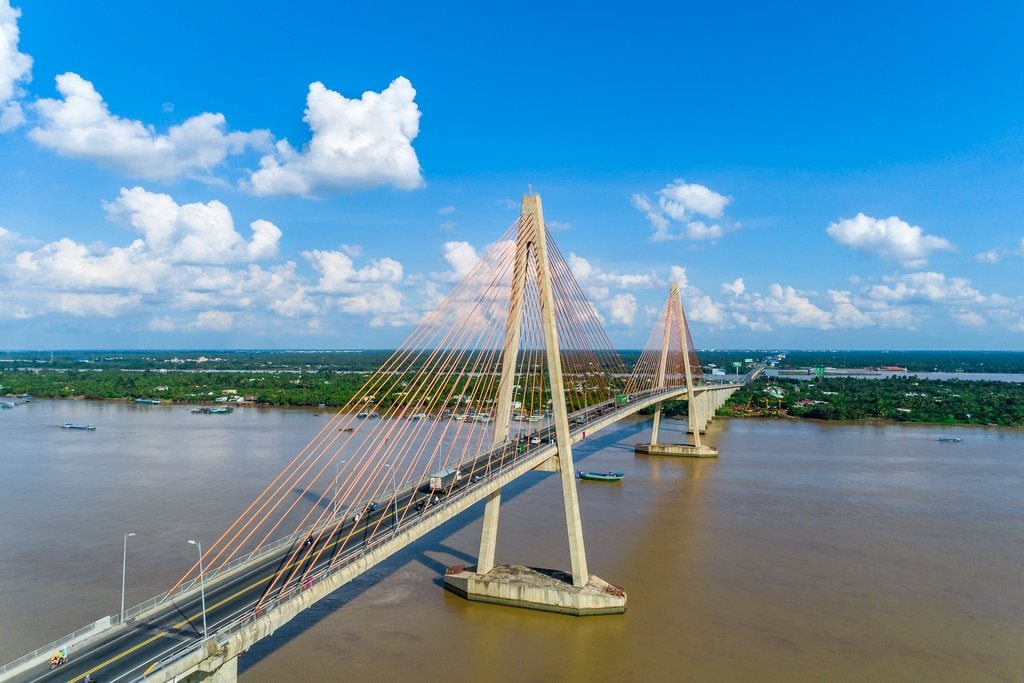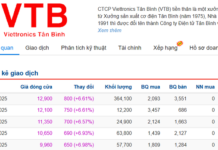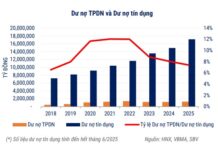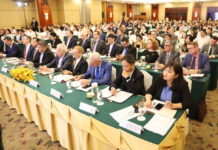
Rạch Miễu Bridge (Photo: Internet)
Almost 16 years ago, on August 20, 2008, the Rạch Miễu Bridge officially joined two shores, marking a pivotal moment in the history of Vietnam’s bridge and road construction industry. For the first time, Vietnam’s transportation infrastructure development sector independently designed, constructed, supervised, and completed a cable-stayed bridge with 100% domestic capital. The design and supervision were undertaken by the General Consultancy Design Corporation (under the Ministry of Transport).
The project was implemented through a build-operate-transfer (BOT) investment model. With a total investment of approximately 1,400 billion VND, the project combined 58% state budget capital and 42% BOT capital. The BOT capital investor was a joint venture of Cienco 1, Cienco 5, and Cienco 6 (under the Ministry of Transport).
While there were previous cable-stayed bridges like the Mỹ Thuận and Bãi Cháy bridges, they were designed and constructed by foreign entities and relied on foreign loans.
Spanning the Tiền River, which once separated Bến Tre from the Mekong Delta, the Rạch Miễu Bridge construction began in April 2002. With a total length of 8,331 meters, the bridge is 2,878 meters long and 12 meters wide (the cable-stayed section is 16 meters wide), accommodating two lanes for cars, two lanes for non-motorized vehicles, and a pedestrian lane. The bridge’s navigation clearance is 37.5m x 220m.
Prior to the Rạch Miễu Bridge, Bến Tre was relatively “isolated” in terms of road transportation. Travelers had to rely on the Rạch Miễu ferry, resulting in time-consuming journeys and waiting periods, especially during holidays when ferry congestion was common. This directly impacted the flow of goods and people between Bến Tre and the provinces of the Mekong Delta.
According to the Bến Tre Provincial Portal, those who used the Rạch Miễu ferry (connecting Bến Tre and Tiền Giang) often experienced anxiety due to the time-consuming process. This ferry crossing spanned 3.2 kilometers as it navigated around the Phụng and Thới Sơn islets on the Tiền River, between the Rạch Miễu and Mỹ Tho ferry terminals.
For the 100-ton ferry, the river crossing took 25-30 minutes. The 40-ton express ferry reduced the travel time to 13-14 minutes, while the 60-ton ferry took nearly 20 minutes. The Rạch Miễu ferry terminal had 13 100-ton ferries, one 60-ton ferry, and two 40-ton ferries.
According to statistics from the Bến Tre Ferry Enterprise at the end of 2007, the ferry crossing recorded 428.2 trips per day, carrying nearly 50,000 passengers, 158,717 motorcycles, and over 30,865 vehicles, including non-motorized ones. On average, a ferry departed every 5-10 minutes, yet during holidays and festive seasons, ferry congestion was inevitable.
The inauguration of the Rạch Miễu Bridge was expected to ensure smooth traffic flow, aligning with the planning for the improvement of National Highway 60, connecting Bến Tre with the provinces of Tiền Giang, Trà Vinh, Sóc Trăng, Long An, and Ho Chi Minh City. It also aimed to alleviate the persistent traffic congestion at the Rạch Miễu ferry terminal.
Additionally, the completion of the bridge was anticipated to boost investment attraction and stimulate the socio-economic development of the region. According to the Bến Tre Trade and Investment Promotion Center, the total investment in Bến Tre in 2004 was approximately $5 million, but this figure rose to $23 million in 2006. In 2007, the province witnessed a continuous influx of capital from various sources.
In 2008, Bến Tre’s competitiveness index ranked 14th out of 64 provinces and cities, a significant improvement from its 2006 ranking. Most recently, in 2023, Bến Tre secured 7th place nationwide in the Provincial Competitiveness Index (PCI), 3rd in the Mekong Delta, and climbed 6 ranks compared to its 2022 PCI position.
In November 2020, the Prime Minister approved the investment policy for the Rạch Miễu 2 Bridge project, connecting Tiền Giang and Bến Tre provinces. On March 29, 2022, the construction of the Rạch Miễu 2 Bridge officially commenced.

Design rendering of Rạch Miễu 2 Bridge. Image: My Thuan Project Management Board
Located about 3.8 km from the existing Rạch Miễu Bridge, the Rạch Miễu 2 Bridge has a total length of 17.6 km and a scale of six lanes. The starting point is at the Đồng Tâm intersection (the intersection of National Highway 1 and Provincial Road 870) in Châu Thành District, Tiền Giang Province, and the endpoint connects to National Highway 60 at the Hàm Luông Bridge approach in Bến Tre City, Bến Tre Province.
According to Decision No. 1083/QD-TTg dated September 18, 2023, approving the adjustment of the investment policy for the Rạch Miễu 2 Bridge construction project, the implementation period is from 2021 to 2026. The total investment for the project is over 6,810 billion VND (previously 5,200 billion VND).
The construction of the Rạch Miễu 2 Bridge, connecting Tiền Giang and Bến Tre provinces, is a step towards completing the transportation network in the region. It aims to meet the growing transportation demands along National Highway 60, promote economic development, and ensure national defense and security in Tiền Giang and Bến Tre provinces, as well as contribute to the overall development of the Mekong Delta and the country.
The Power of Delegation: Empowering Local Leadership for Efficient Governance
Inaugurating the Government’s law-themed session on the morning of September 23rd, Prime Minister Pham Minh Chinh emphasized the need to enhance decentralization and delegation of authority. He stressed that subordinates should not have to “ask” for permission from higher-ups for every minor matter and that decisions should be based on established regulations. The Prime Minister underscored the importance of empowering lower levels of government to make decisions independently, without having to seek approval from the central authorities for every trivial issue.
SpaceX Plans to Invest Billions in Vietnam in the Coming Years
SpaceX’s Senior Vice President, Tim Hughes, has stated that Vietnam is a highly promising market for the company’s satellite internet development plans. The corporation intends to invest billions of dollars in the country in the coming years, recognizing the potential for growth and expansion within the Vietnamese market.
The Signature Collection by Van Phu – Invest: Introducing Vlasta to Hai Phong’s Thuy Nguyen District
With over two decades of experience in developing urban projects in major cities across Vietnam, Van Phu – Invest is a leading real estate company in the country. Now, for the first time, they are bringing a landmark project to Thuỷ Nguyên, the rising economic center of the North.











































